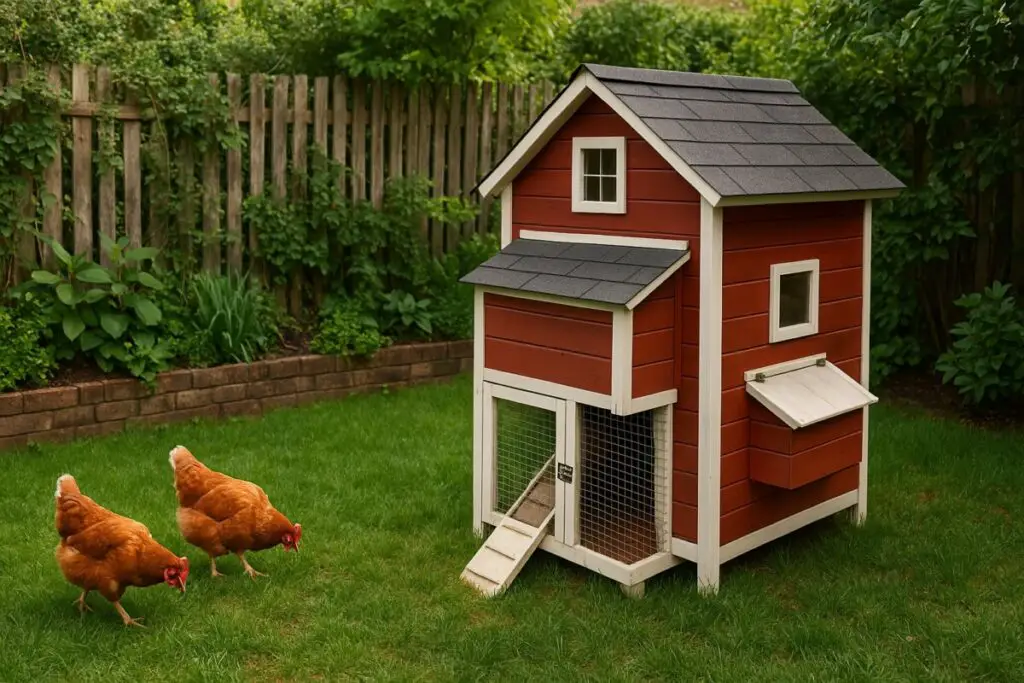
A Cozy Setup for Happy Hens (Even in the City)
Backyard chickens in the city? Yep, it’s totally doable—and honestly, kind of amazing. We’ve been seeing more and more folks turning patios, side yards, and even rooftops into little hen havens. And the best part? You don’t need a ton of space or a fancy setup to get started.
Now, finding a chicken coop that actually works for smaller spaces (without looking like a mini prison or falling apart in the rain) can be a bit of a hunt. That’s where this guide comes in. Whether you’ve got three hens and a dream or you’re just starting to plan your setup, we’re going to walk you through some solid, compact coop options that are easy to maintain, safe for your flock, and look pretty good, too.
We’ve also included our favorite picks from Amazon—stuff we’ve tried, stuff that’s well-reviewed, and coops that hit the sweet spot between function and footprint.
So let’s get into it—and help you set up something your hens will be proud to call home.
Benefits of Raising Chickens in Urban Spaces
Turns out, chickens aren’t just for farms. They’re right at home in backyards, patios, and even tucked-away city corners. If you’re thinking about starting your own little flock, here’s why it might just be one of the best backyard decisions you’ll ever make.
1. Fresh Eggs, Right at Your Doorstep
This one’s a no-brainer. With just a few hens, you can collect fresh, healthy eggs every morning—no store trip needed.
Typical Yield from Common Urban-Friendly Breeds:
| Chicken Breed | Eggs per Year | Egg Color | Temperament |
|---|---|---|---|
| Buff Orpington | 250–280 | Brown | Calm and friendly |
| Plymouth Rock | 200–250 | Brown | Hardy and social |
| Australorp | 250–300 | Light brown | Quiet and easygoing |
These breeds do well in smaller spaces and are known for being beginner-friendly.
2. A Natural Way to Reduce Food Waste
Chickens eat more scraps than you might think. Fruit peels, veggie bits, stale bread—they’ll turn all that into eggs and fertilizer.
Plus: They help reduce what ends up in your trash bin, which is a win for your garden and the planet.
3. Built-In Pest Control
Got a bug problem in your garden beds? Chickens love a good bug hunt. They’ll scratch around and eat up:
- Slugs
- Grubs
- Beetles
- Mosquito larvae (yes, really)
It’s like having your own feathered pest patrol.
4. Great for Kids (and Curious Adults)
Raising chickens teaches responsibility, routine, and care. Kids get to learn where food comes from—not just the fridge—and honestly, watching hens scratch and cluck is more entertaining than half the shows out there.

5. Fantastic Fertilizer for Your Garden
Chicken manure is high in nitrogen and other nutrients that help plants thrive. Just make sure it’s composted first—it’s strong stuff!
Chicken Manure vs. Other Organic Fertilizers:
| Fertilizer Type | Nitrogen (N) | Phosphorus (P) | Potassium (K) | Best For |
|---|---|---|---|---|
| Chicken Manure (aged) | High | Medium | Medium | Veggie beds, fast growers |
| Cow Manure | Medium | Low | Medium | General garden use |
| Compost | Medium | Medium | Medium | All-purpose soil boost |
6. A Feel-Good Way to Be More Self-Sufficient
Even a few hens can give you that “we’re doing something real here” feeling. You’re creating food, reducing waste, and doing it all right in your own space. That’s something to feel pretty good about.

Key Considerations When Choosing a Compact Coop
When you’re working with limited space, choosing the right coop matters a lot. You don’t need the biggest or the fanciest—you just need something that works well for your flock, your yard, and your daily routine.
Here’s what to look for when picking out a coop for your urban setup:
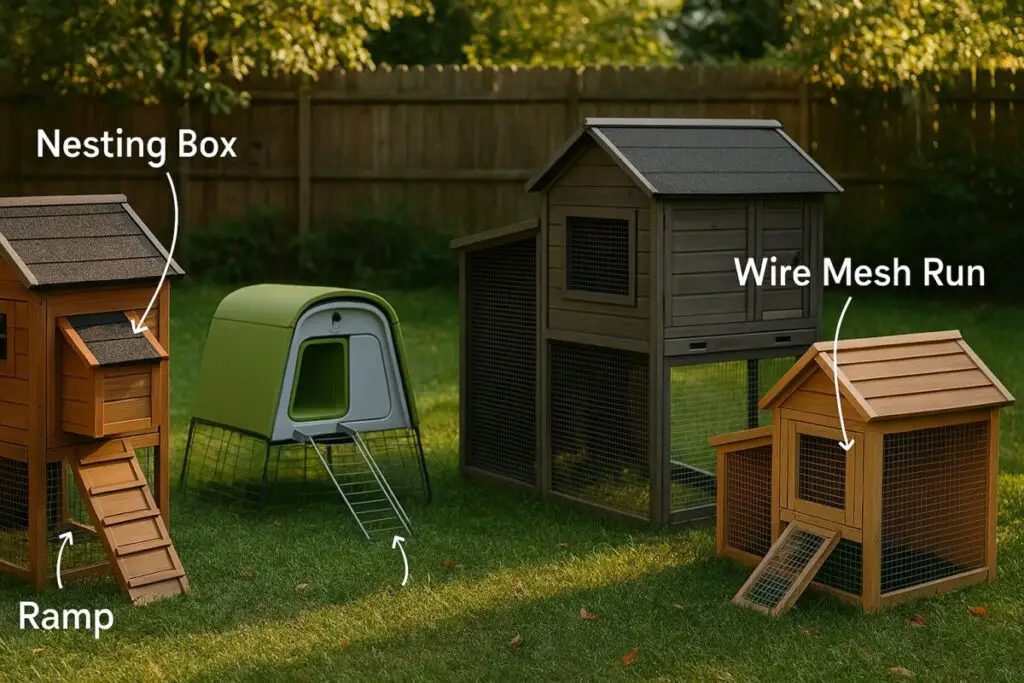
1. Size and Space Efficiency
Rule of thumb: Aim for about 2–3 square feet per chicken inside the coop, plus 8–10 square feet per chicken in the run.
If you’re tight on outdoor space, look for coops that:
- Have a vertical design (like stacked nesting and roosting areas)
- Include a built-in run so you don’t need to build a separate pen
- Can be moved easily, especially if you’re rotating grazing areas
Try this:
PawHut Compact Wooden Chicken Coop with Outdoor Run – Easy to move around the yard and has a cozy, all-in-one footprint for 2–3 hens.
2. Predator Protection
City raccoons, neighborhood dogs, even hawks—urban chickens still need protection.
Look for coops with:
- Galvanized wire mesh (not flimsy chicken wire)
- Lockable latches on doors and nesting boxes
- Raised sleeping quarters to keep hens safe at night
Top Pick:
Pets Imperial® Windsor Coop – Solid build, reinforced locks, and elevated roosting area for extra safety.
3. Weatherproofing & Ventilation
Whether you’re in a rainy coastal town or dealing with freezing winters, your coop needs to keep your flock dry and ventilated.
Key features to look for:
- Sloped or waterproof roofs
- Good airflow without drafts (vents under the eaves work great)
- Insulated panels or a design that supports seasonal add-ons
Smart option:
Tucker Murphy Pet™ Outdoor Chicken Coop with Asphalt Roof – Keeps things dry, even in the rainy season, and has vented windows for airflow.
4. Ease of Cleaning
A coop that’s hard to clean becomes a problem fast. Look for:
- Pull-out trays under the roosts
- Wide-opening doors for easy access
- Removable nesting boxes or dividers
Backyard-friendly pick:
Aivituvin Mobile Chicken Tractor – Roll it to a new spot, pop open the doors, and clean it out in under 10 minutes.
5. Coop Aesthetics (Yes, It Matters!)
Let’s be real—if it’s going in your backyard, you want it to look halfway decent. Many modern coops are designed with both form and function in mind.
- Neutral paint tones blend in with gardens
- Rustic wood finishes look charming next to raised beds
- Modern plastic builds (like the Omlet Eglu Go) are sleek and easy to clean
Stylish pick:
Omlet Eglu Go Chicken Coop – Colorful, modern, and surprisingly spacious for 2–4 hens.
Quick Comparison: What Coop’s Best for You?
| Product Name | Hens | Mobile? | Standout Feature | Best For |
|---|---|---|---|---|
| PawHut Compact Coop | 2–3 | Yes | Budget-friendly, easy to move | Beginners & small yards |
| Pets Imperial® Windsor | 3–5 | No | Great predator protection | Safer, stationary setup |
| Aivituvin Mobile Tractor | 2–4 | Yes | Super easy to clean | Gardeners who like to rotate |
| Tucker Murphy Pet Coop | 2–3 | No | Weatherproof design | Rainy climates |
| Omlet Eglu Go | 2–4 | No | Stylish, modern, low maintenance | Urban patios or clean aesthetics |
Top 5 Compact Chicken Coops for Urban Setups [2025 Review]
We’ve rounded up five of the most reliable, space-smart, and beginner-friendly coops for small urban yards. These aren’t your flimsy, fall-apart-in-a-week setups. These are tried-and-true picks that’ll keep your hens happy and your mornings egg-filled.
1. PawHut Compact Wooden Chicken Coop with Outdoor Run
Perfect For: Beginners and small patios
Why We Like It:
- Simple setup and budget-friendly
- Lightweight and easy to move
- Built-in nesting box with lid for egg access
Pros:
- Great starter size for 2 hens
- Compact footprint with enclosed run
- Weather-treated wood
Cons:
- Thin wood may need reinforcing over time
- Limited space—better for occasional outdoor time
Quick Specs:
| Feature | Details |
|---|---|
| Capacity | 1–2 hens |
| Dimensions | 66″ L x 30″ W x 39″ H |
| Nesting Boxes | 1 (with hinged top) |
| Run Included | Yes |
2. Pets Imperial® Windsor Chicken Coop
Perfect For: Cozy backyards needing extra security
Why We Like It:
- Built tough with reinforced predator-proof mesh
- Elevated design keeps things clean and dry
- Classy, rustic look that fits any garden
Pros:
- Roomy interior for 3–5 hens
- Pull-out tray makes cleaning a breeze
- Strong locks on all doors
Cons:
- Assembly takes some time
- Not easily moved once in place
Quick Specs:
| Feature | Details |
|---|---|
| Capacity | 3–5 hens |
| Dimensions | 66″ L x 29″ W x 43″ H |
| Nesting Boxes | 2 |
| Run Included | Optional (sold separately) |
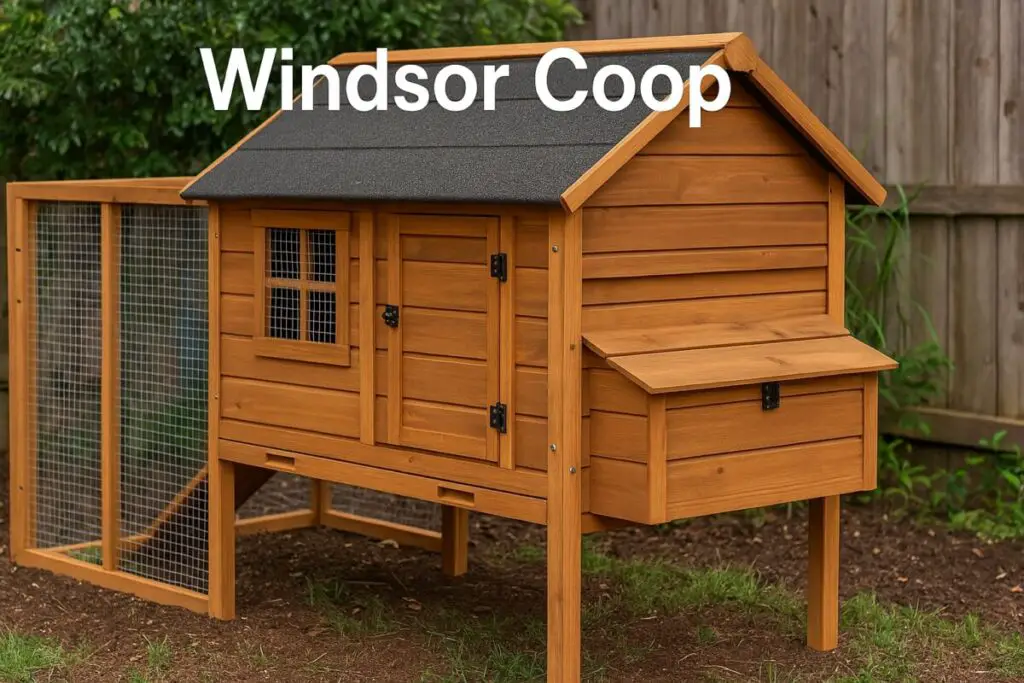
3. Aivituvin Mobile Chicken Tractor
Perfect For: Gardeners who like to rotate their flock for fresh grass
Why We Like It:
- Wheels make it easy to move across the yard
- Built-in run and roost area
- Solid design with plenty of airflow
Pros:
- Easy to clean and relocate
- Ideal for grass rotation and pest control
- Weather-resistant materials
Cons:
- Can feel snug for more than 2–3 hens
- Nesting box access could be better placed
Quick Specs:
| Feature | Details |
|---|---|
| Capacity | 2–3 hens |
| Dimensions | 79″ L x 26″ W x 51″ H |
| Nesting Boxes | 1 |
| Run Included | Yes (attached) |
4. Tucker Murphy Pet™ Outdoor Chicken Coop with Asphalt Roof
Perfect For: Rainy climates and shaded backyards
Why We Like It:
- Waterproof asphalt roof keeps the interior dry
- Dual nesting boxes with separate access
- Simple, sturdy frame with plenty of ventilation
Pros:
- Great for 2–3 hens
- Stands up well to wet weather
- Easy access to eggs and bedding area
Cons:
- Not predator-proof unless reinforced
- Instructions could be clearer
Quick Specs:
| Feature | Details |
|---|---|
| Capacity | 2–3 hens |
| Dimensions | 65″ L x 30″ W x 40″ H |
| Nesting Boxes | 2 |
| Run Included | Yes |
5. Omlet Eglu Go Chicken Coop
Perfect For: Urban homesteaders who want style + low maintenance
Why We Like It:
- Easy-to-clean plastic design
- Modern look that doesn’t scream “barnyard”
- Add-on runs and wheels available
Pros:
- No rot or rust—lasts for years
- Surprisingly warm in winter
- Easy access nesting tray
Cons:
- Pricey compared to wooden coops
- Accessories (run, wheels) sold separately
Quick Specs:
| Feature | Details |
|---|---|
| Capacity | 2–4 hens |
| Dimensions | 33″ L x 24″ W x 21″ H (coop only) |
| Nesting Boxes | 1 integrated |
| Run Included | Optional (modular add-on) |
DIY vs. Pre-Made Coops: Which One’s Right for You?
There’s something satisfying about building your own chicken coop. But there’s also something really nice about opening a box, grabbing a screwdriver, and being done before dinner. So which is better—DIY or pre-made?
Let’s break it down.
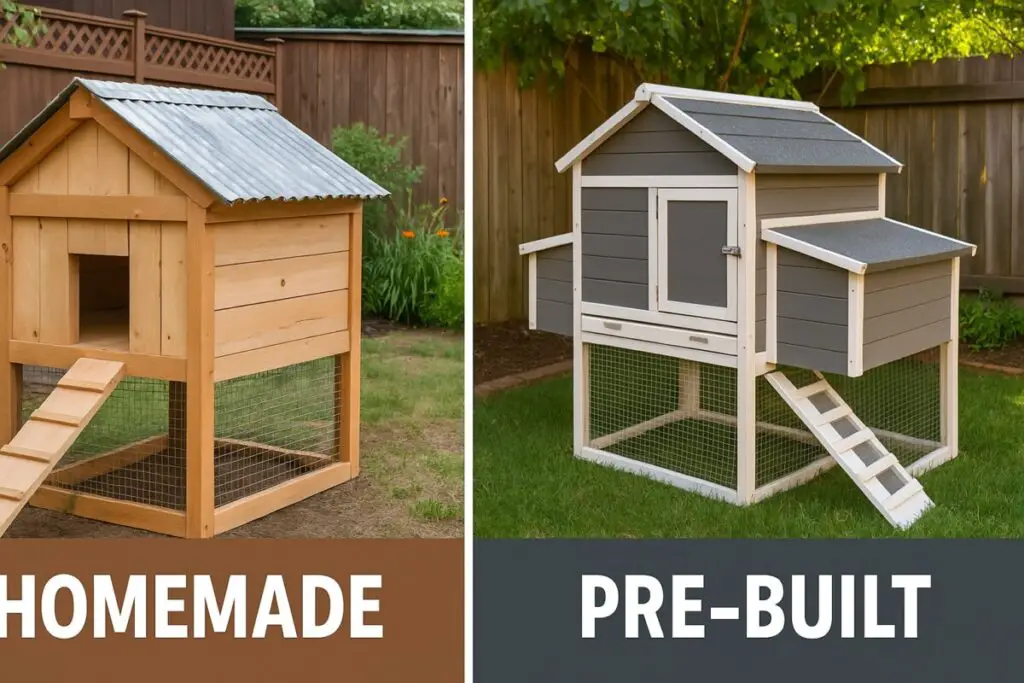
DIY Chicken Coops
If you’re handy with tools (or at least a good set of instructions), building your own coop can be a fun weekend project.
Pros:
- Custom size and layout to fit your space perfectly
- Usually cheaper if you already have materials
- Can add your own creative touches
Cons:
- Takes time—usually more than you think
- Needs tools, space, and a bit of construction know-how
- If you get it wrong, you might be rebuilding it next month
Best For:
- Tinkerers, budget-conscious builders, and folks with unique yard setups
Pre-Made Chicken Coops
These are the coops you can order online, assemble with minimal tools, and have your hens moved in by the weekend.
Pros:
- Super convenient and often easy to assemble
- Designed with chicken health and safety in mind
- Lots of size and style options available
Cons:
- Quality can vary—some models may need upgrades over time
- May not perfectly fit your space or specific needs
Best For:
- Beginners, busy folks, or anyone who wants to get started now
DIY vs. Pre-Made: Quick Comparison
| Factor | DIY Coop | Pre-Made Coop |
|---|---|---|
| Cost | Can be cheaper (if materials on hand) | Often higher, but ready to go |
| Time Investment | High—expect 1–2 weekends | Low—assemble in 2–4 hours |
| Customization | Fully customizable | Limited to available designs |
| Durability | Depends on your build quality | Varies—some very sturdy options |
| Skill Required | Moderate to high | Low |
Not Sure Which Way to Go?
Here’s a little decision helper:
- Go DIY if you love building, have a quirky space to fit, or want a coop that doubles as a weekend project.
- Go Pre-Made if you’re ready to get started fast, prefer convenience, or want a tried-and-true setup that just works.
And hey, there’s no wrong answer—either way, your hens are going to love having a safe, comfy place to roost.
Coop Setup Checklist for First-Time Urban Chicken Keepers
Before you bring home your hens, it’s worth double-checking that your setup is solid. A little planning now saves you a lot of headaches later.
Here’s everything you need to have in place before those happy clucks move in.
1. Check Local Rules & Zoning Laws
First things first—make sure chickens are allowed in your area. Some cities limit how many you can keep or require permits (especially for roosters, which are usually a no-go in tight neighborhoods).
- Check your city website or call your local code enforcement office
- Look for restrictions on coop placement or distance from neighbors
- HOA? Yep, check those rules too
2. Choose the Right Location in Your Yard
You’ll want a spot with good drainage, some shade, and easy access for you (and your garden hose).
Pro tip: Keep the coop close enough to your house that you can check on the hens quickly, but not so close that you smell it through the kitchen window.
3. Coop Essentials (Don’t Skip These)
You’ve got the coop—but there’s a handful of must-have gear to go along with it.
| Item | Why You Need It | Recommended Product |
|---|---|---|
| Feeder | Keeps food clean and dry | Harris Farms Hanging Feeder |
| Waterer | Constant access to fresh water is non-negotiable | RentACoop No-Spill Waterer |
| Bedding | Helps control odor, absorbs moisture | Manna Pro Fresh Flake Pine Shavings |
| Nesting Box Filler | Makes it comfy and clean for egg-laying | Happy Hen Nesting Pads |
| Roosting Bar | Chickens need a place to perch at night | Often built into coops, or buy separately |
| Predator Guard Locks | Optional upgrade for extra security | Heavy-Duty Locking Carabiners |
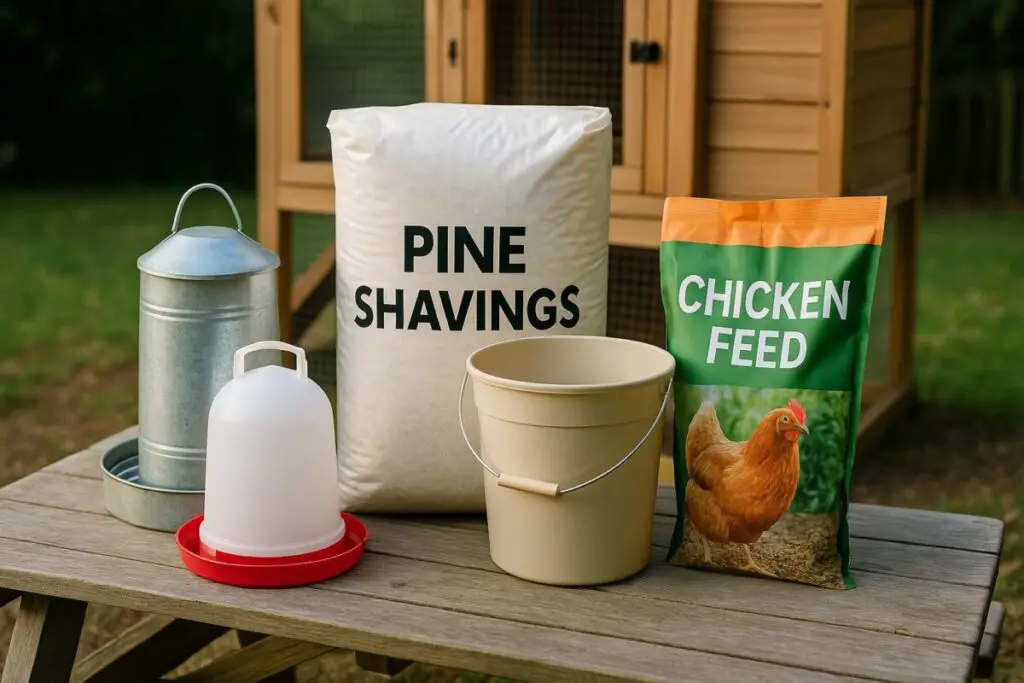
4. Pick the Right Chicken Breeds for Urban Life
Some breeds are louder, more active, or bigger than others. Stick with calm, compact, and cold/heat-tolerant breeds like:
- Silkies – small, fluffy, quiet
- Buff Orpingtons – gentle, great layers
- Australorps – reliable egg producers and very chill
- Barred Plymouth Rocks – hardy and friendly
5. Food, Grit & Extras
You’ll need a solid bag of layer feed, plus grit (tiny stones) to help them digest food properly.
Optional—but recommended:
- Calcium supplements for strong eggshells
- Scratch grains for treats
- Coop deodorizer (like Sweet PDZ or First Saturday Lime) for fresh smells
6. First-Day Setup: Your Quick Checklist
Here’s a printable-friendly list to have on hand:
- [ ] Coop fully assembled and secure
- [ ] Water and feeder filled and in place
- [ ] Bedding laid down in coop and nesting boxes
- [ ] Entry points double-checked for predators
- [ ] Shade and airflow working as needed
- [ ] Chickens safely introduced (preferably in the morning)
Maintenance Tips to Keep Your Urban Coop Clean and Healthy
A clean coop is a happy coop. And more importantly, it means healthier hens, fewer flies, and no angry neighbors. Don’t worry—this doesn’t mean hours of scrubbing every weekend. With the right setup and a simple routine, coop maintenance can be quick and painless.
1. Create a Simple Cleaning Schedule
Here’s a no-fuss breakdown of what needs doing and how often:
| Task | How Often | Why It Matters |
|---|---|---|
| Refill feeder & waterer | Daily | Chickens need clean food and water, always |
| Scoop droppings from roost area | Every 2–3 days | Keeps smells down and bedding fresh |
| Replace nesting material | Weekly | Cleaner eggs, happier hens |
| Full coop cleanout | Every 2–4 weeks | Stops ammonia buildup and pest issues |
| Deep clean & disinfect | Every 3–6 months | Prevents mites and bacteria long-term |
Tip: Keep a small rake and a bucket with a lid next to the coop—it makes quick cleanups feel like no big deal.
2. Use the Right Bedding and Deodorizers
The bedding you choose can make or break your coop-cleaning experience. Look for options that are:
- Absorbent
- Low-dust
- Easy to compost
Recommended bedding options:
- Manna Pro Fresh Flake Pine Shavings – great all-around choice
- Hemp Bedding – super absorbent, low-odor
- Sweet PDZ Coop Refresher – neutralizes ammonia and smells fresh
3. Install Pull-Out Trays (or Get a Coop That Has One)
If your coop has a removable tray under the roost, you’ve already won half the cleaning battle.
No tray? You can:
- Add a plastic boot tray or oil drip pan under roosting bars
- Line it with newspaper or pine shavings for easy scooping
- Dump it right into your compost bin or green waste pile
4. Keep Flies and Odors in Check
Urban coops are close to homes, patios, and fences, so fly and smell control is a big deal.
What helps:
- Sprinkle First Saturday Lime or diatomaceous earth under bedding
- Hang fly traps nearby but not directly over the coop
- Keep food and water stations clean—scrub them weekly with vinegar or gentle soap
Top Picks:
- First Saturday Lime – natural pest repellent & odor control
- Catchmaster Outdoor Fly Traps – safe and effective
5. Watch for Moisture Buildup
Even in small backyard coops, dampness leads to stink—and worse, it can mess with your chickens’ health.
Prevent it by:
- Opening vents or windows during the day
- Replacing wet bedding immediately after rain
- Raising the coop a few inches off the ground if it sits in a shady, wet spot
Sample Weekly Maintenance Routine (10–15 min max)
| Day | Task |
|---|---|
| Monday | Refill food & water, check vents |
| Wednesday | Scoop poop tray, freshen bedding |
| Friday | Quick wipe down of feeders/waterers |
| Sunday | Replace nesting material, check for damage or pests |
Keeping your coop fresh doesn’t have to be a chore. Just set a rhythm, use the right supplies, and your flock (and your nose) will thank you.
Click here to download a Chicken Coop Weekly Maintenance Checklist (PDF)
FAQs About Urban Chicken Coops
Got questions? You’re definitely not the only one. Here are some of the most common things folks ask when they’re thinking about raising chickens in a small space.
1. How many chickens can I keep in a small backyard?
It depends on your local laws, but most urban setups do well with 2–4 hens. That’s enough for a steady supply of eggs without overcrowding. Just remember: each chicken needs 2–3 sq ft inside the coop and 8–10 sq ft in the run for comfort.
2. Are chickens allowed in cities?
In many places, yes—but with rules. Some cities have limits on flock size, require permits, or ban roosters. Check your local zoning laws and HOA rules before building or buying your coop.
Tip: Stick with hens—they’re quiet, productive, and far less likely to ruffle neighborly feathers.
3. What’s the best coop for a tiny space or patio?
Look for a compact or vertical design with a built-in run, like the
PawHut Compact Coop or the modular Omlet Eglu Go. These work well in tight spaces and are easy to clean—plus they look good in small yards.
4. Do chicken coops smell bad?
Not if you keep up with basic cleaning. Use absorbent bedding like pine shavings or hemp, and sprinkle in a coop refresher (like Sweet PDZ) every few days. Scoop droppings regularly and make sure the coop has good airflow to prevent moisture and ammonia buildup.
5. Can I build my own coop instead of buying one?
Absolutely! DIY coops are great if you’re handy and want a custom fit. Just make sure it’s:
- Predator-proof (use hardware cloth, not chicken wire)
- Weather-resistant
- Easy to clean (think pull-out trays or wide doors)
That said, if you’re short on time or tools, a pre-made coop like the Pets Imperial Windsor is a solid, low-stress choice.
Final Thoughts + Recommendations
So there you have it—your complete guide to choosing and setting up a compact chicken coop in the city. Whether you’re working with a cozy patio, a corner of the backyard, or even a rooftop garden, urban chickens are totally doable—and totally worth it.
Let’s recap the big stuff:
- Start with the right coop: Something safe, space-smart, and weather-ready
- Add the essentials: Feeders, waterers, nesting boxes, and good bedding
- Stick to a simple cleaning routine to keep things healthy and smell-free
- Pick friendly breeds that do well in small spaces (hello, Orpingtons and Australorps)
If you’re still on the fence, here are our top two favorites depending on your vibe:
| Need something simple and affordable? | Want style and low-maintenance? |
|---|---|
| PawHut Compact Wooden Coop | Omlet Eglu Go |
| Great for beginners with limited space | Sleek, modern, and lasts for years |
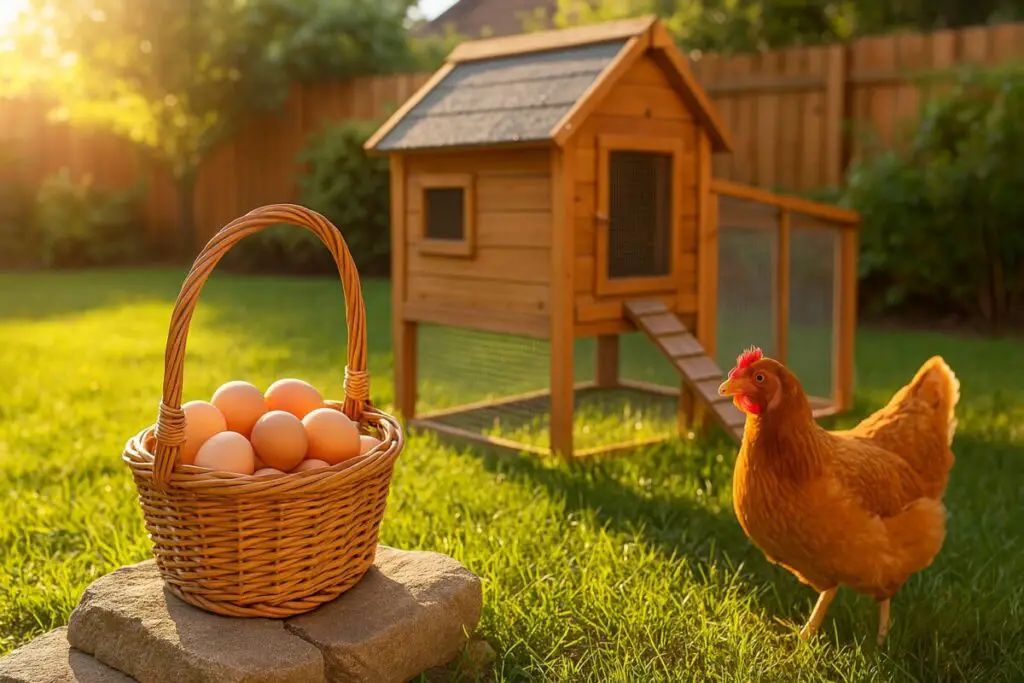
Ready to Start Your Urban Chicken Adventure?
There’s no better time than now. Your fresh eggs, garden fertilizer, and flock of quirky little friends are waiting.
Click here to shop top-rated compact chicken coops on Amazon and get your backyard setup rolling today.

